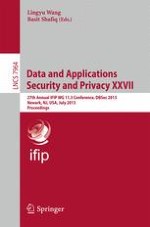2013 | Book
Data and Applications Security and Privacy XXVII
27th Annual IFIP WG 11.3 Conference, DBSec 2013, Newark, NJ, USA, July 15-17, 2013. Proceedings
Editors: Lingyu Wang, Basit Shafiq
Publisher: Springer Berlin Heidelberg
Book Series : Lecture Notes in Computer Science
